Quantitative Retrieval of Soil Salinity in Arid Regions: A Radar Feature Space Approach with Fully Polarimetric SAR Data
Abstract
1. Introduction
2. Materials and Methods
2.1. Study Area
2.2. Remote Sensing Data and Preprocessing
2.3. Soil Sample Collection and Laboratory Analysis
2.4. Methods
2.4.1. Polarimetric SAR (PolSAR) Target Decomposition
2.4.2. Correlation Analysis and Feature Selection
2.4.3. Normalization of Feature Parameters
2.4.4. RSMI Model
3. Results
3.1. Validation of the Accuracy of the RSMI Model
3.2. Analysis of Spatial Pattern of Salinization Using the Yamaguchi4_vol-Freeman3_vol Feature Space
3.3. RSMI Model-Based Quantitative Retrieval of Soil Salinity
4. Discussion
4.1. RSMI Model Generalizability Analysis
4.2. Advantages, Limitations and Future Work
5. Conclusions
- (1)
- In this study, through correlation analysis between 36 polarimetric components and the actual soil electrical conductivity, we successfully identified two key features, Yamaguchi4_vol and Freeman3_vol, which were significantly correlated (both p < 0.001) with the actual soil electrical conductivity, with correlation coefficients of −0.67 and −0.63, respectively. These results confirm the potential of polarimetric features in soil salinity retrieval.
- (2)
- The RSMI model proposed in this study achieved a higher correlation (r = 0.85) with the soil surface salinity. The linear fit between the values obtained using the RSMI model and the measured soil electrical conductivity values yielded an R2 value of 0.72 and an RMSE of 7.28 dS/m, validating the effectiveness and reliability of the RSMI model in monitoring the different degrees of soil salinization. Furthermore, when applied to the Weiku Oasis using RADARSAT-2 data, the model maintained good performance (R2 = 0.70, RMSE = 9.29 dS/m), demonstrating its potential for regional application in similar arid environments.
- (3)
- In the study area, the degree of soil salinization exhibits a spatial pattern of gradually increasing from the center of the oasis toward its periphery. This pattern is consistent with field observations, providing an intuitive radar remote sensing interpretation of the spatial distribution characteristics of the soil salinization in the Yutian Oasis.
Author Contributions
Funding
Institutional Review Board Statement
Informed Consent Statement
Data Availability Statement
Acknowledgments
Conflicts of Interest
References
- Wang, F.; Ding, J.; Wu, M. Remote Sensing Monitoring Models of Soil Salinization Based on NDVI-SI Feature Space. Trans. Chin. Soc. Agric. Eng. 2010, 26, 168–173. [Google Scholar]
- Wang, N.; Peng, J.; Chen, S.; Huang, J.; Li, H.; Biswas, A.; He, Y.; Shi, Z. Improving Remote Sensing of Salinity on Topsoil with Crop Residues Using Novel Indices of Optical and Microwave Bands. Geoderma 2022, 422, 115935. [Google Scholar] [CrossRef]
- Yang, J.; Yao, R.; Wang, X.; Xie, W.; Zhang, X.; Zhu, W.; Zhang, L.; Sun, R. Research on Salt-Affected Soils in China: History, Status Quo and Prospect. Acta Pedol. Sin. 2022, 59, 10–27. [Google Scholar]
- Li, Y.; Liu, C.; Liang, Z.; Wang, X.; Fan, X.; Liu, D.L.; Biswas, A. Effect of Biochar on Soil Properties and Infiltration in a Light Salinized Soil: Experiments and Simulations. Eur. J. Soil Sci. 2022, 73, e13279. [Google Scholar] [CrossRef]
- Peng, J.; Biswas, A.; Jiang, Q.; Zhao, R.; Hu, J.; Hu, B.; Shi, Z. Estimating Soil Salinity from Remote Sensing and Terrain Data in Southern Xinjiang Province, China. Geoderma 2019, 337, 1309–1319. [Google Scholar] [CrossRef]
- Allbed, A.; Kumar, L.; Aldakheel, Y.Y. Assessing Soil Salinity Using Soil Salinity and Vegetation Indices Derived from IKONOS High-Spatial Resolution Imageries: Applications in a Date Palm Dominated Region. Geoderma 2014, 230, 1–8. [Google Scholar] [CrossRef]
- Taghizadeh-Mehrjardi, R.; Minasny, B.; Sarmadian, F.; Malone, B.P. Digital Mapping of Soil Salinity in Ardakan Region, Central Iran. Geoderma 2014, 213, 15–28. [Google Scholar] [CrossRef]
- Scudiero, E.; Skaggs, T.H.; Corwin, D.L. Regional-Scale Soil Salinity Assessment Using Landsat ETM plus Canopy Reflectance. Remote Sens. Environ. 2015, 169, 335–343. [Google Scholar] [CrossRef]
- Verstraete, M.M.; Pinty, B. Designing Optimal Spectral Indexes for Remote Sensing Applications. IEEE Trans. Geosci. Remote Sens. 1996, 34, 1254–1265. [Google Scholar] [CrossRef]
- Ivushkin, K.; Bartholomeus, H.; Bregt, A.K.; Pulatov, A.; Kempen, B.; de Sousa, L. Global Mapping of Soil Salinity Change. Remote Sens. Environ. 2019, 231, 111260. [Google Scholar] [CrossRef]
- Guo, B.; Zang, W.; Zhang, R. Soil Salizanation Information in the Yellow River Delta Based on Feature Surface Models Using Landsat 8 OLI Data. IEEE Access 2020, 8, 94394–94403. [Google Scholar] [CrossRef]
- Liu, J.; Zhang, L.; Dong, T.; Wang, J.; Fan, Y.; Wu, H.; Geng, Q.; Yang, Q.; Zhang, Z. The Applicability of Remote Sensing Models of Soil Salinization Based on Feature Space. Sustainability 2021, 13, 13711. [Google Scholar] [CrossRef]
- AbdelRahman, M.A.E.; Afifi, A.A.; D’Antonio, P.; Gabr, S.S.; Scopa, A. Detecting and Mapping Salt-Affected Soil with Arid Integrated Indices in Feature Space Using Multi-Temporal Landsat Imagery. Remote Sens. 2022, 14, 2599. [Google Scholar] [CrossRef]
- Zhao, C.; Zhang, H.; Song, C.; Zhu, J.-K.; Shabala, S. Mechanisms of Plant Responses and Adaptation to Soil Salinity. Innovation 2020, 1, 100017. [Google Scholar] [CrossRef]
- Dey, S.; Bhattacharya, A.; Ratha, D.; Mandal, D.; Frery, A.C. Target Characterization and Scattering Power Decomposition for Full and Compact Polarimetric SAR Data. IEEE Trans. Geosci. Remote Sens. 2021, 59, 3981–3998. [Google Scholar] [CrossRef]
- Sawada, Y.; Koike, T.; Aida, K.; Toride, K.; Walker, J.P. Fusing Microwave and Optical Satellite Observations to Simultaneously Retrieve Surface Soil Moisture, Vegetation Water Content, and Surface Soil Roughness. IEEE Trans. Geosci. Remote Sens. 2017, 55, 6195–6206. [Google Scholar] [CrossRef]
- Romanov, A.N.; Khvostov, I.V.; Ryabinin, I.V.; Troshkin, D.N.; Romanov, D.A. Remote Microwave Soil Drought Index Considering Dielectric Properties of Soil. IEEE Trans. Geosci. Remote Sens. 2023, 61, 4408208. [Google Scholar] [CrossRef]
- He, L.; Panciera, R.; Tanase, M.A.; Walker, J.P.; Qin, Q. Soil Moisture Retrieval in Agricultural Fields Using Adaptive Model-Based Polarimetric Decomposition of SAR Data. IEEE Trans. Geosci. Remote Sens. 2016, 54, 4445–4460. [Google Scholar] [CrossRef]
- Oleschko, K.; Korvin, G.; Balankin, A.S.; Khachaturov, R.V.; Flores, L.; Figueroa, B.; Urrutia, J.; Brambila, F. Fractal Scattering of Microwaves from Soils. Phys. Rev. Lett. 2002, 89, 188501. [Google Scholar] [CrossRef]
- Sun, G.-C.; Liu, Y.; Xing, M.; Wang, S.; Guo, L.; Yang, J. A Real-Time Imaging Algorithm Based on Sub-Aperture CS-Dechirp for GF3-SAR Data. Sensors 2018, 18, 2562. [Google Scholar] [CrossRef]
- Xu, M.; Guo, B.; Zhang, R. A Novel Approach to Detecting the Salinization of the Yellow River Delta Using a Kernel Normalized Difference Vegetation Index and a Feature Space Model. Sustainability 2024, 16, 2560. [Google Scholar] [CrossRef]
- Ding, J.; Yao, Y.; Wang, F. Detecting Soil Salinization in Arid Regions Using Spectral Feature Space Derived from Remote Sensing Data. Acta Ecol. Sin. 2014, 34, 4620–4631. [Google Scholar]
- Li, Y.; Ding, J.; Yongmeng, S.; Gang, W.; Lu, W. Remote Sensing Monitoring Models of Soil Salinization Based on the Three Dimensional Feature Space of MSAVI-WI-SI. Res. Soil Water Conserv. 2015, 22, 113–117+121. [Google Scholar]
- Bian, L.; Wang, J.; Guo, B.; Cheng, K.; Wei, H. Remote Sensing Extraction of Soil Salinity in Yellow River Delta Kenli County Based on Feature Space. Remote Sens. Technol. Appl. 2020, 35, 211–218. [Google Scholar]
- Wu, Z.; Yan, Q.; Zhang, S.; Lei, S.; Lu, Q.; Hua, X. Remote Sensing Monitoring of Soil Salinization Based on SI-Brightness Feature Space and Drivers Analysis: A Case Study of Surface Mining Areas in Semi-Arid Steppe. IEEE Access 2021, 9, 110137–110148. [Google Scholar] [CrossRef]
- Guo, B.; Yang, F. A Novel Feature Space Monitoring Index of Salinisation in the Yellow River Delta Based on SENTINEL-2B MSI Images. Land Degrad. Dev. 2022, 33, 2303–2316. [Google Scholar] [CrossRef]
- Ma, Y.; Tashpolat, N. Remote Sensing Monitoring of Soil Salinity in Weigan River–Kuqa River Delta Oasis Based on Two-Dimensional Feature Space. Water 2023, 15, 1694. [Google Scholar] [CrossRef]
- Muhetaer, N.; Nurmemet, I.; Abulaiti, A.; Xiao, S.; Zhao, J. A Quantifying Approach to Soil Salinity Based on a Radar Feature Space Model Using ALOS PALSAR-2 Data. Remote Sens. 2022, 14, 363. [Google Scholar] [CrossRef]
- Nurmemet, I.; Sagan, V.; Ding, J.-L.; Halik, Ü.; Abliz, A.; Yakup, Z. A WFS-SVM Model for Soil Salinity Mapping in Keriya Oasis, Northwestern China Using Polarimetric Decomposition and Fully PolSAR Data. Remote Sens. 2018, 10, 598. [Google Scholar] [CrossRef]
- Lü, X.; Nurmemet, I.; Xiao, S.; Zhao, J.; Yu, X.; Aili, Y.; Li, S. Spatial-Temporal Simulation and Prediction of Root Zone Soil Moisture Based on Hydrus-1D and CNN-LSTM-Attention in the Yutian Oasis, Southern Xinjiang, China. Pedosphere 2024. [Google Scholar] [CrossRef]
- Han, L.; Ding, J.; Ge, X.; He, B.; Wang, J.; Xie, B.; Zhang, Z. Using Spatiotemporal Fusion Algorithms to Fill in Potentially Absent Satellite Images for Calculating Soil Salinity: A Feasibility Study. Int. J. Appl. Earth Obs. Geoinf. 2022, 111, 102839. [Google Scholar] [CrossRef]
- Ren, B.; Ma, S.; Hou, B.; Hong, D.; Chanussot, J.; Wang, J.; Jiao, L. A Dual-Stream High Resolution Network: Deep Fusion of GF-2 and GF-3 Data for Land Cover Classification. Int. J. Appl. Earth Obs. Geoinf. 2022, 112, 102896. [Google Scholar] [CrossRef]
- Ding, K.; Yang, J.; Lin, H.; Wang, Z.; Wang, D.; Wang, X.; Ni, K.; Zhou, Q. Towards Real-Time Detection of Ships and Wakes with Lightweight Deep Learning Model in Gaofen-3 SAR Images. Remote Sens. Environ. 2023, 284, 113345. [Google Scholar] [CrossRef]
- Zhu, Y.; Liu, K.; Myint, S.W.; Du, Z.; Li, Y.; Cao, J.; Liu, L.; Wu, Z. Integration of GF2 Optical, GF3 SAR, and UAV Data for Estimating Aboveground Biomass of China’s Largest Artificially Planted Mangroves. Remote Sens. 2020, 12, 2039. [Google Scholar] [CrossRef]
- Gao, Y.; Liu, X.; Hou, W.; Han, Y.; Wang, R.; Zhang, H. Characteristics of Saline Soil in Extremely Arid Regions: A Case Study Using GF-3 and ALOS-2 Quad-Pol SAR Data in Qinghai, China. Remote Sens. 2021, 13, 417. [Google Scholar] [CrossRef]
- Lasne, Y.; Paillou, P.; Freeman, A.; Farr, T.; McDonald, K.C.; Ruffie, G.; Malezieux, J.-M.; Chapman, B.; Demontoux, F. Effect of Salinity on the Dielectric Properties of Geological Materials: Implication for Soil Moisture Detection by Means of Radar Remote Sensing. IEEE Trans. Geosci. Remote Sens. 2008, 46, 1674–1688. [Google Scholar] [CrossRef]
- Wang, Y.; Ainsworth, T.L.; Lee, J.-S. Assessment of System Polarization Quality for Polarimetric SAR Imagery and Target Decomposition. IEEE Trans. Geosci. Remote Sens. 2011, 49, 1755–1771. [Google Scholar] [CrossRef]
- Banerjee, B.; Bhattacharya, A.; Buddhiraju, K.M. A Generic Land-Cover Classification Framework for Polarimetric SAR Images Using the Optimum Touzi Decomposition Parameter Subset-an Insight on Mutual Information-Based Feature Selection Techniques. IEEE J. Sel. Top. Appl. Earth Obs. Remote Sens. 2014, 7, 1167–1176. [Google Scholar] [CrossRef]
- Aghababaee, H.; Sahebi, M.R. Model-Based Target Scattering Decomposition of Polarimetric SAR Tomography. IEEE Trans. Geosci. Remote Sens. 2018, 56, 972–983. [Google Scholar] [CrossRef]
- Wang, H.; Magagi, R.; Goita, K.; Duguay, Y.; Trudel, M.; Muhuri, A. Retrieval Performances of Different Crop Growth Descriptors from Full- and Compact-Polarimetric SAR Decompositions. Remote Sens. Environ. 2023, 285, 113381. [Google Scholar] [CrossRef]
- Merchant, M.A.; Adams, J.R.; Berg, A.A.; Baltzer, J.L.; Quinton, W.L.; Chasmer, L.E. Contributions of C-Band SAR Data and Polarimetric Decompositions to Subarctic Boreal Peatland Mapping. IEEE J. Sel. Top. Appl. Earth Obs. Remote Sens. 2017, 10, 1467–1482. [Google Scholar] [CrossRef]
- Shan, Z.; Wang, C.; Zhang, H.; An, W. Improved Four-Component Model-Based Target Decomposition for Polarimetric SAR Data. IEEE Geosci. Remote Sens. Lett. 2012, 9, 75–79. [Google Scholar] [CrossRef]
- Fu, B.; Li, H.; Liu, M.; Yao, H.; Gao, E.; Sun, W.; Zhang, S.; Fan, D. Performance Evaluation of Backscattering Coefficients and Polarimetric Decomposition Parameters for Marsh Vegetation Mapping Using Multi-Sensor and Multi-Frequency SAR Images. Ecol. Indic. 2023, 157, 111246. [Google Scholar] [CrossRef]
- Jagdhuber, T.; Hajnsek, I.; Papathanassiou, K.P. An Iterative Generalized Hybrid Decomposition for Soil Moisture Retrieval under Vegetation Cover Using Fully Polarimetric SAR. IEEE J. Sel. Top. Appl. Earth Obs. Remote Sens. 2015, 8, 3911–3922. [Google Scholar] [CrossRef]
- Zhang, L.; Meng, Q.; Zeng, J.; Wei, X.; Shi, H. Evaluation of Gaofen-3 C-Band SAR for Soil Moisture Retrieval Using Different Polarimetric Decomposition Models. IEEE J. Sel. Top. Appl. Earth Obs. Remote Sens. 2021, 14, 5707–5719. [Google Scholar] [CrossRef]
- Anconitano, G.; Lavalle, M.; Acuña, M.A.; Pierdicca, N. Sensitivity of Polarimetric SAR Decompositions to Soil Moisture and Vegetation over Three Agricultural Sites across a Latitudinal Gradient. IEEE J. Sel. Top. Appl. Earth Obs. Remote Sens. 2024, 17, 3615–3634. [Google Scholar] [CrossRef]
- Zhang, H.; Xie, L.; Wang, C.; Wu, F.; Zhang, B. Investigation of the Capability of H-α Decomposition of Compact Polarimetric SAR. IEEE Geosci. Remote Sens. Lett. 2014, 11, 868–872. [Google Scholar] [CrossRef]
- Pottier, E.; Cloude, S.R. Application of the H/a/Alpha Polarimetric Decomposition Theorem for Land Classification; Mott, H., Boerner, W.-M., Eds.; SPIE: San Diego, CA, USA, 1997; pp. 132–143. [Google Scholar]
- Huynen, J.R. Phenomenological Theory of Radar Targets. In Electromagnetic Scattering; Elsevier: Amsterdam, The Netherlands, 1978; pp. 653–712. ISBN 978-0-12-709650-6. [Google Scholar]
- Krogager, E. New Decomposition of the Radar Target Scattering Matrix. Electron. Lett. 1990, 26, 1525–1527. [Google Scholar] [CrossRef]
- Touzi, R.; Lopes, A. The Principle of Speckle Filtering in Polarimetric SAR Imagery. IEEE Trans. Geosci. Remote Sens. 1994, 32, 1110–1114. [Google Scholar] [CrossRef]
- Cloude, S.R.; Pottier, E. A Review of Target Decomposition Theorems in Radar Polarimetry. IEEE Trans. Geosci. Remote Sens. 1996, 34, 498–518. [Google Scholar] [CrossRef]
- Freeman, A.; Saatchi, S.S. On the Detection of Faraday Rotation in Linearly Polarized L-Band SAR Backscatter Signatures. IEEE Trans. Geosci. Remote Sens. 2004, 42, 1607–1616. [Google Scholar] [CrossRef]
- Yamaguchi, Y.; Moriyama, T.; Ishido, M.; Yamada, H. Four-Component Scattering Model for Polarimetric SAR Image Decomposition. IEEE Trans. Geosci. Remote Sens. 2005, 43, 1699–1706. [Google Scholar] [CrossRef]
- Cameron, W.L.; Rais, H. Conservative Polarimetric Scatterers and Their Role in Incorrect Extensions of the Cameron Decomposition. IEEE Trans. Geosci. Remote Sens. 2006, 44, 3506–3516. [Google Scholar] [CrossRef]
- Neumann, M.; Ferro-Famil, L.; Reigber, A. Estimation of Forest Structure, Ground, and Canopy Layer Characteristics from Multibaseline Polarimetric Interferometric SAR Data. IEEE Trans. Geosci. Remote Sens. 2010, 48, 1086–1104. [Google Scholar] [CrossRef]
- van Zyl, J.J.; Arii, M.; Kim, Y. Model-Based Decomposition of Polarimetric SAR Covariance Matrices Constrained for Nonnegative Eigenvalues. IEEE Trans. Geosci. Remote Sens. 2011, 49, 3452–3459. [Google Scholar] [CrossRef]
- Allbed, A.; Kumar, L. Soil Salinity Mapping and Monitoring in Arid and Semi-Arid Regions Using Remote Sensing Technology: A Review. Adv. Remote Sens. 2013, 2, 373–385. [Google Scholar] [CrossRef]
- Yang, J.; Yamaguchi, Y.; Lee, J.-S.; Touzi, R.; Boerner, W.-M. Applications of Polarimetric SAR. J. Sens. 2015, 2015, 316391. [Google Scholar] [CrossRef]
- Singh, G.; Malik, R.; Mohanty, S.; Rathore, V.; Yamada, K.; Umemura, M.; Yamaguchi, Y. Seven-Component Scattering Power Decomposition of POLSAR Coherency Matrix. IEEE Trans. Geosci. Remote Sens. 2019, 57, 8371–8382. [Google Scholar] [CrossRef]
- Holm, W.A.; Barnes, R.M. On Radar Polarization Mixed Target State Decomposition Techniques. In Proceedings of the 1988 IEEE National Radar Conference, Ann Arbor, MI, USA, 20–21 April 1988; pp. 249–254. [Google Scholar]
- Wang, J.; Ding, J.; Yu, D.; Ma, X.; Zhang, Z.; Ge, X.; Teng, D.; Li, X.; Liang, J.; Lizaga, I.; et al. Capability of Sentinel-2 MSI Data for Monitoring and Mapping of Soil Salinity in Dry and Wet Seasons in the Ebinur Lake Region, Xinjiang, China. Geoderma 2019, 353, 172–187. [Google Scholar] [CrossRef]
- Xiao, S.; Nurmemet, I.; Zhao, J. Soil Salinity Estimation Based on Machine Learning Using the GF-3 Radar and Landsat-8 Data in the Keriya Oasis, Southern Xinjiang, China. Plant Soil 2024, 498, 451–469. [Google Scholar] [CrossRef]
- Pearson, K. VII. Note on Regression and Inheritance in the Case of Two Parents. Proc. R. Soc. Lond. 1895, 58, 240–242. [Google Scholar] [CrossRef]
- Periasamy, S.; Ravi, K.P. A Novel Approach to Quantify Soil Salinity by Simulating the Dielectric Loss of SAR in Three-Dimensional Density Space. Remote Sens. Environ. 2020, 251, 112059. [Google Scholar] [CrossRef]
- Aly, Z.; Bonn, F.J.; Magagi, R. Analysis of the Backscattering Coefficient of Salt-Affected Soils Using Modeling and RADARSAT-1 SAR Data. IEEE Trans. Geosci. Remote Sens. 2007, 45, 332–341. [Google Scholar] [CrossRef]
- Hong, S.-H.; Wdowinski, S. Double-Bounce Component in Cross-Polarimetric SAR from a New Scattering Target Decomposition. IEEE Trans. Geosci. Remote Sens. 2014, 52, 3039–3051. [Google Scholar] [CrossRef]
- Jiang, R.; Sui, Y.; Zhang, X.; Lin, N.; Zheng, X.; Li, B.; Zhang, L.; Li, X.; Yu, H. Estimation of Soil Organic Carbon by Combining Hyperspectral and Radar Remote Sensing to Reduce Coupling Effects of Soil Surface Moisture and Roughness. Geoderma 2024, 444, 116874. [Google Scholar] [CrossRef]
- Arii, M.; Yamada, H.; Kojima, S.; Ohki, M. Review of the Comprehensive SAR Approach to Identify Scattering Mechanisms of Radar Backscatter from Vegetated Terrain. Electronics 2019, 8, 1098. [Google Scholar] [CrossRef]
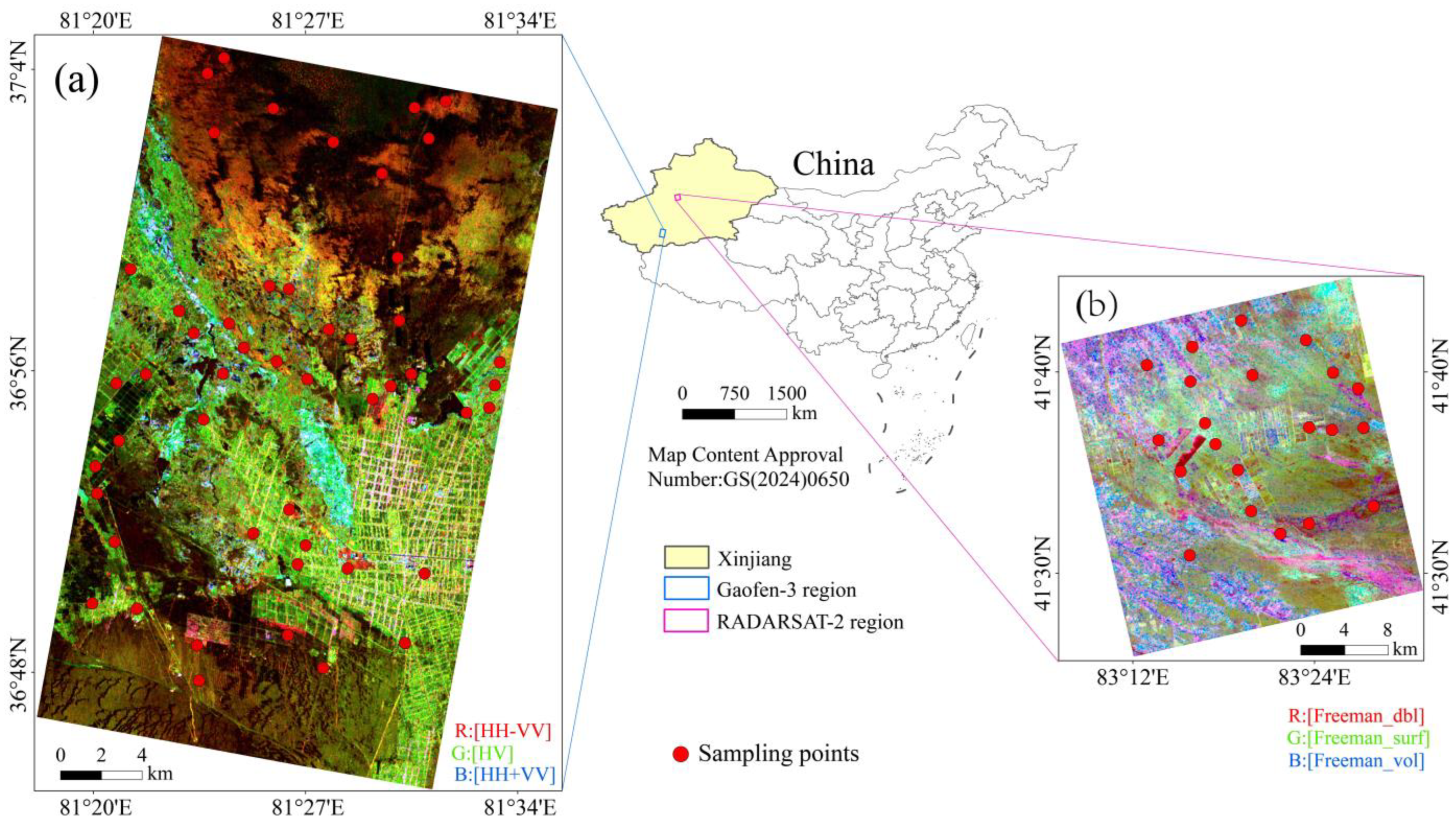
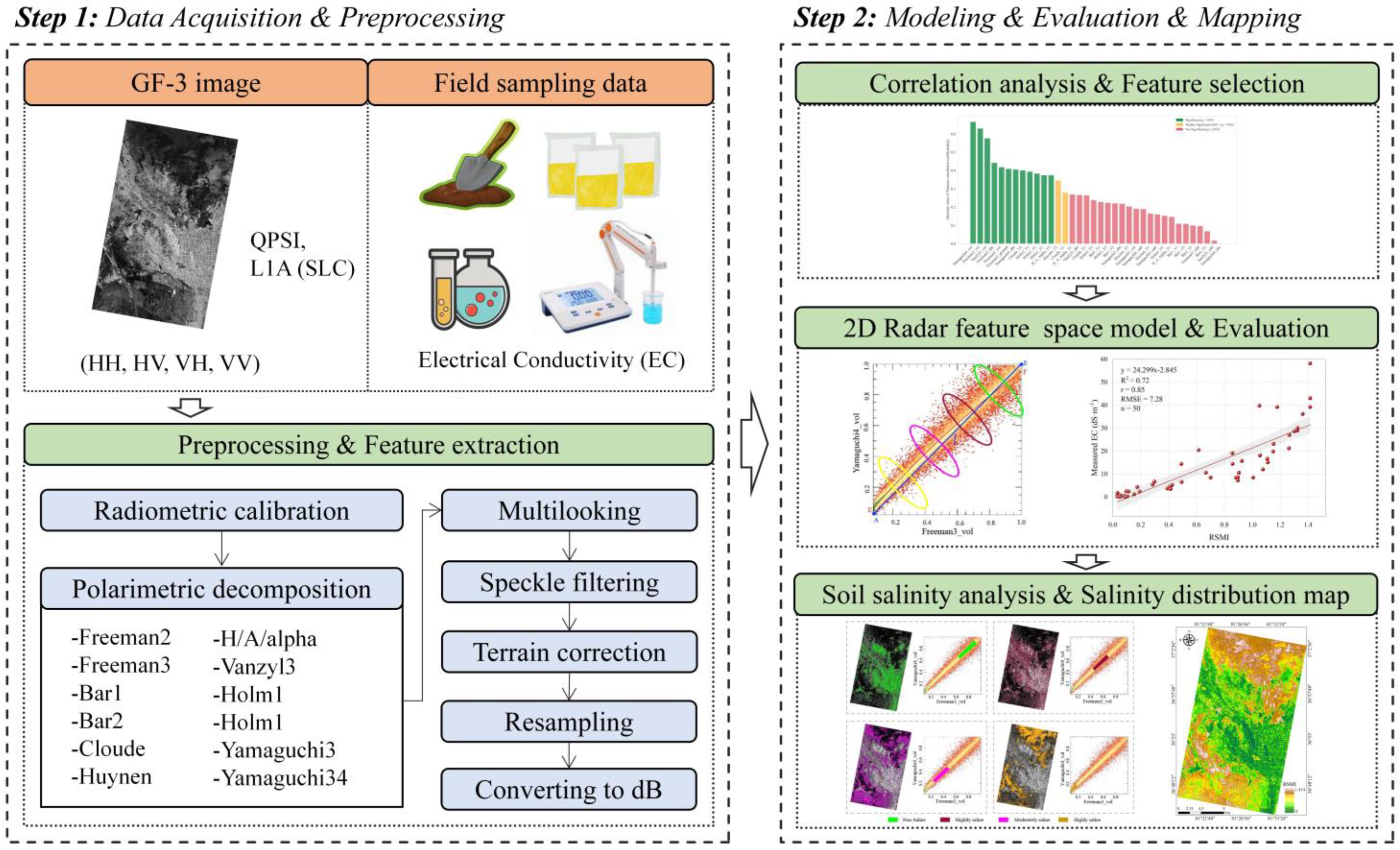
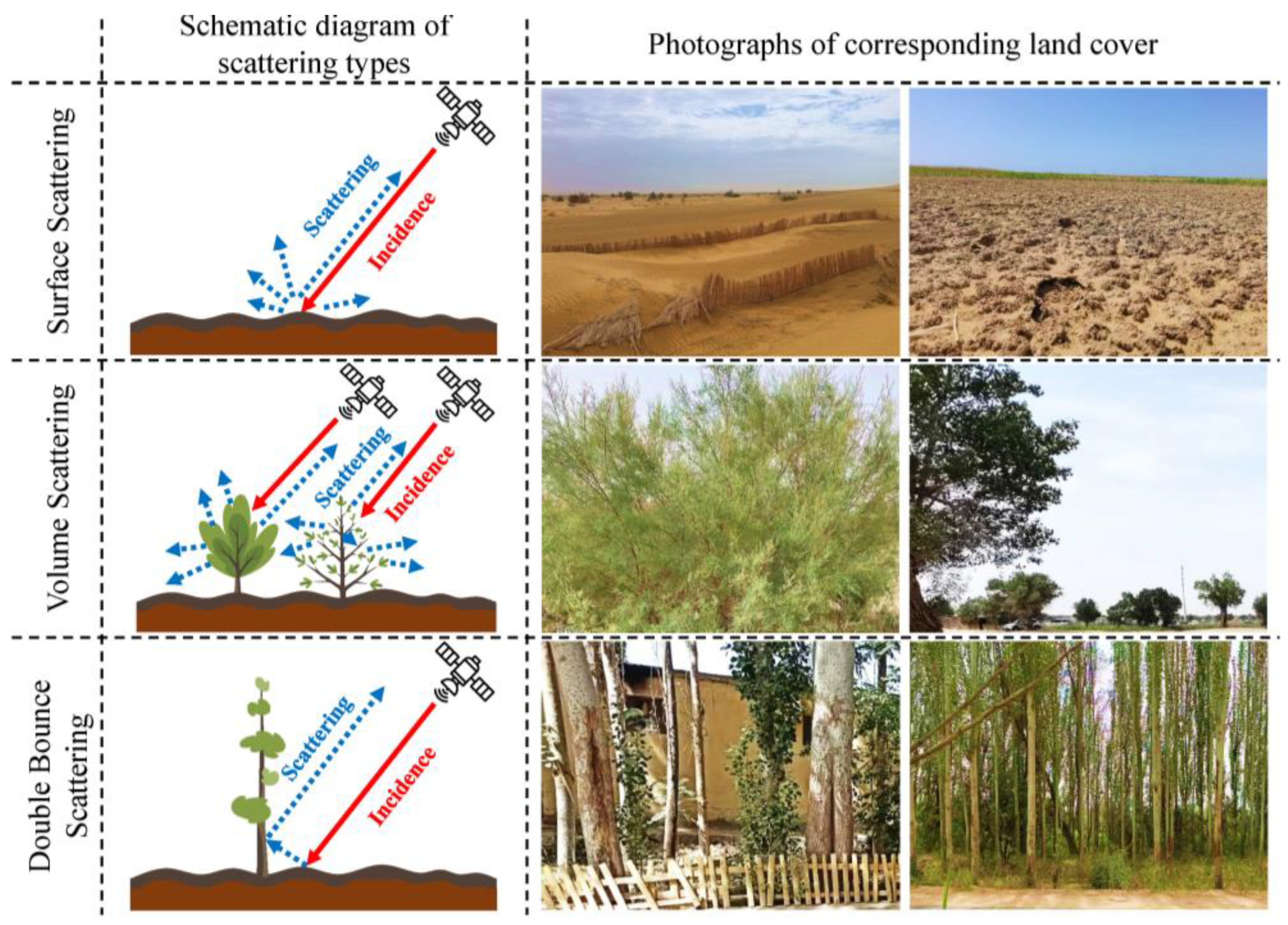
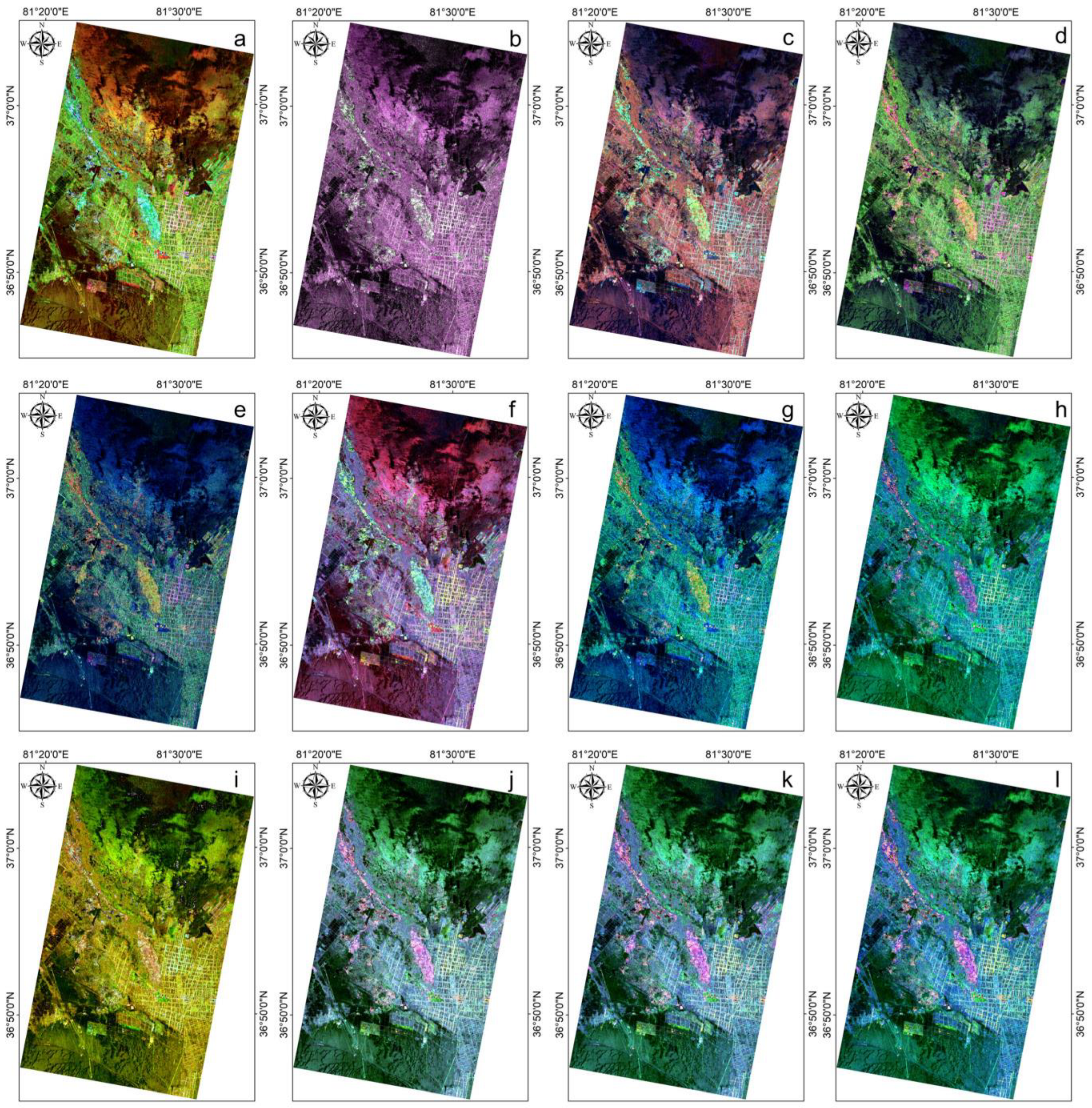
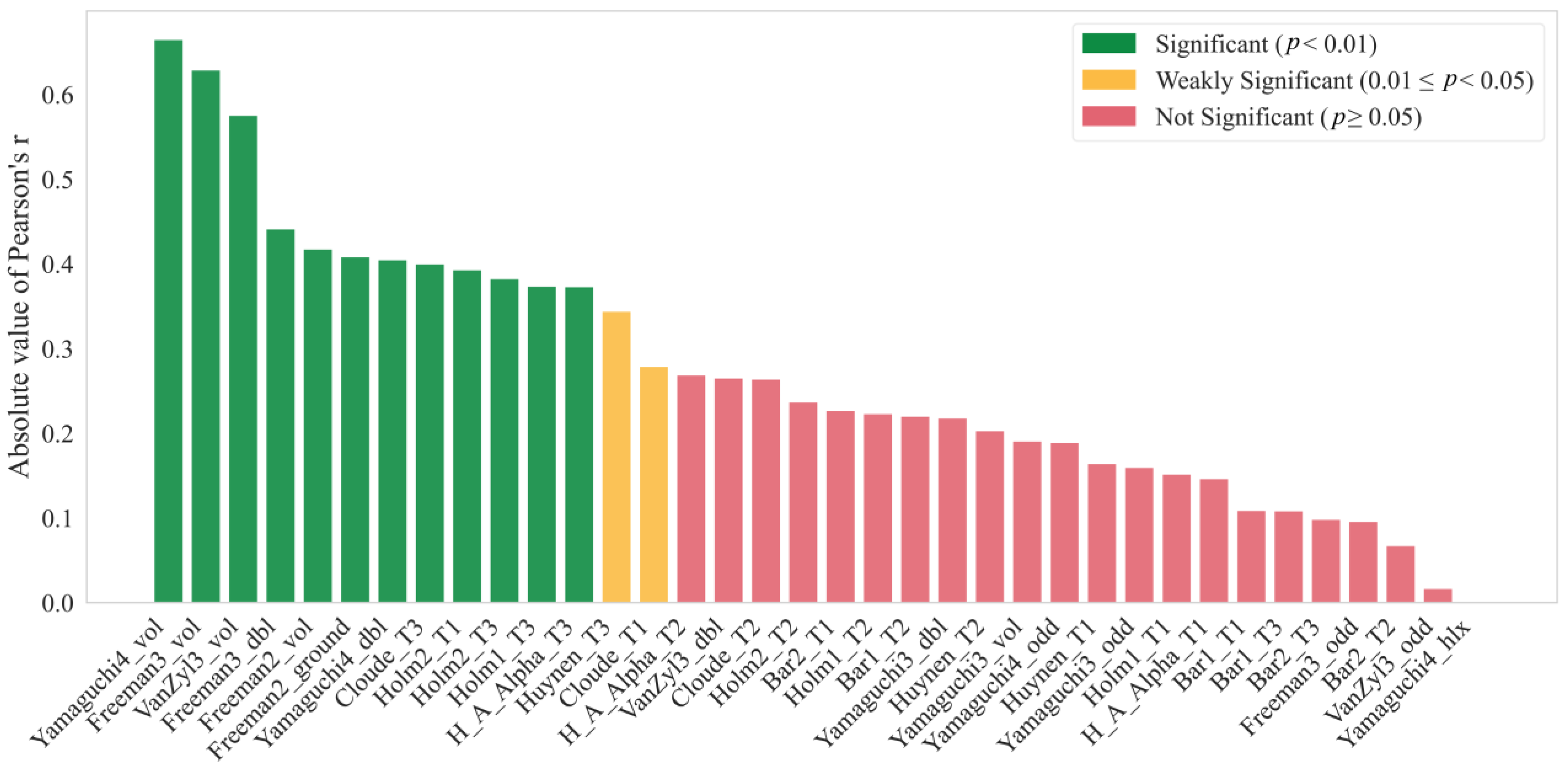

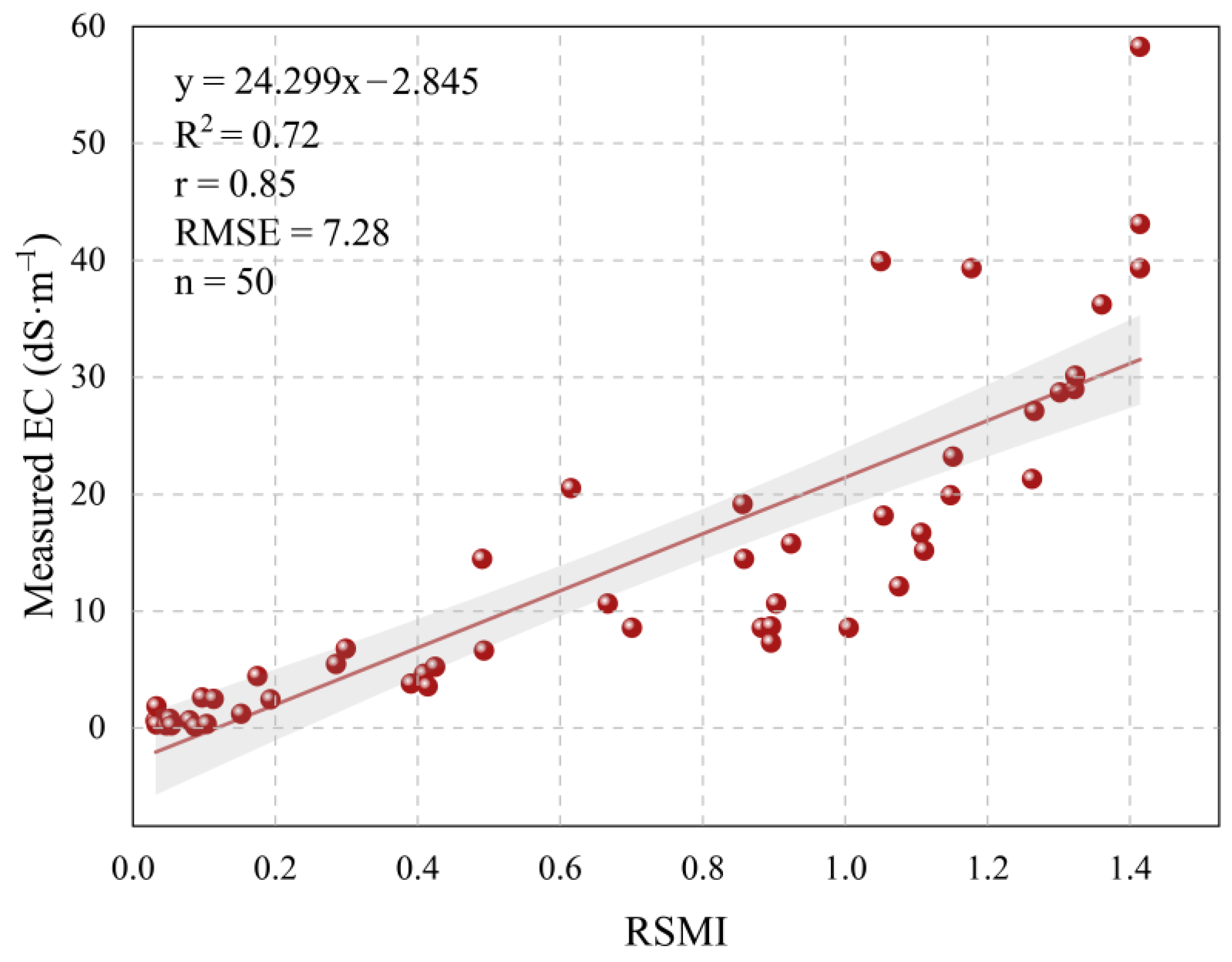

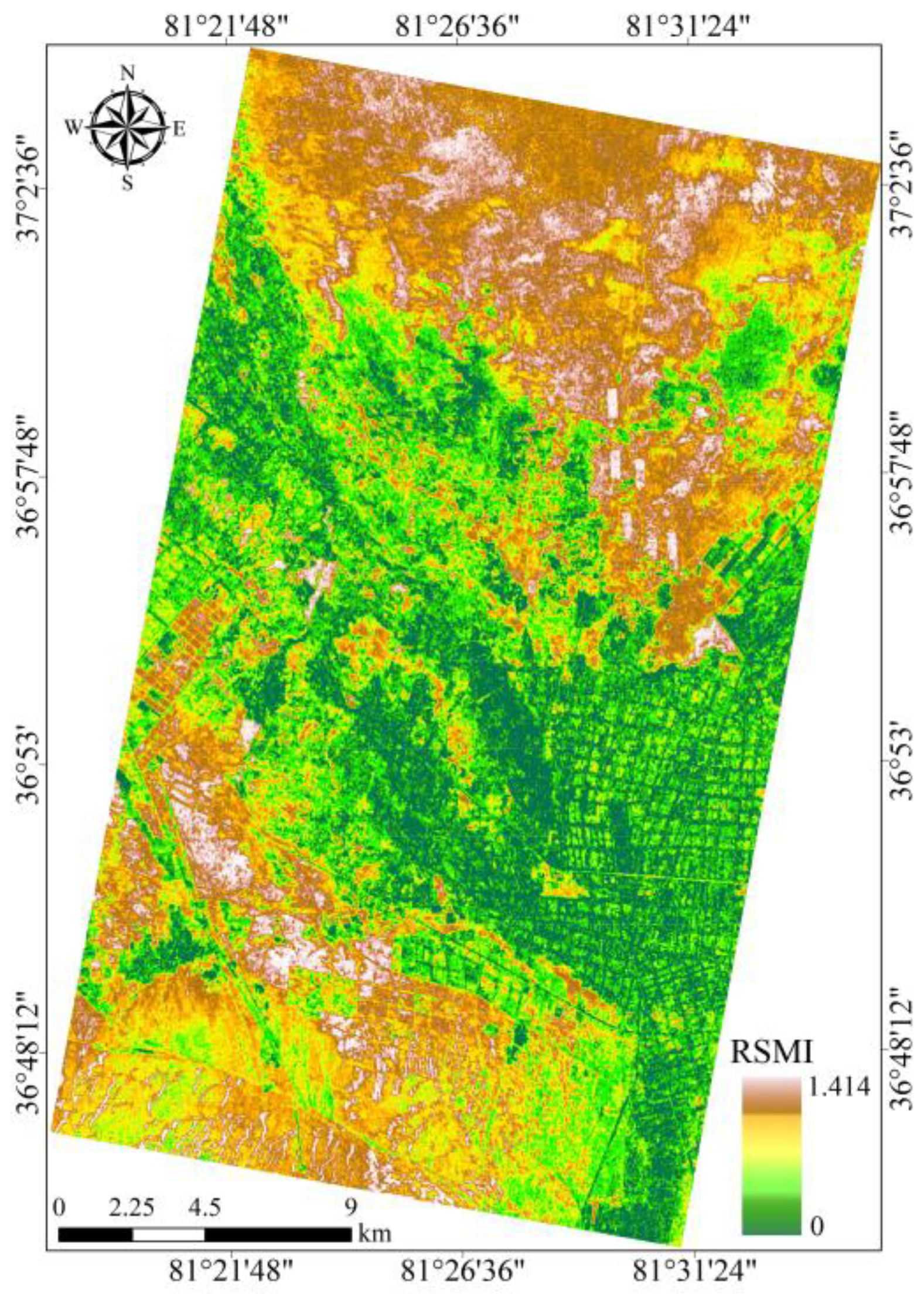
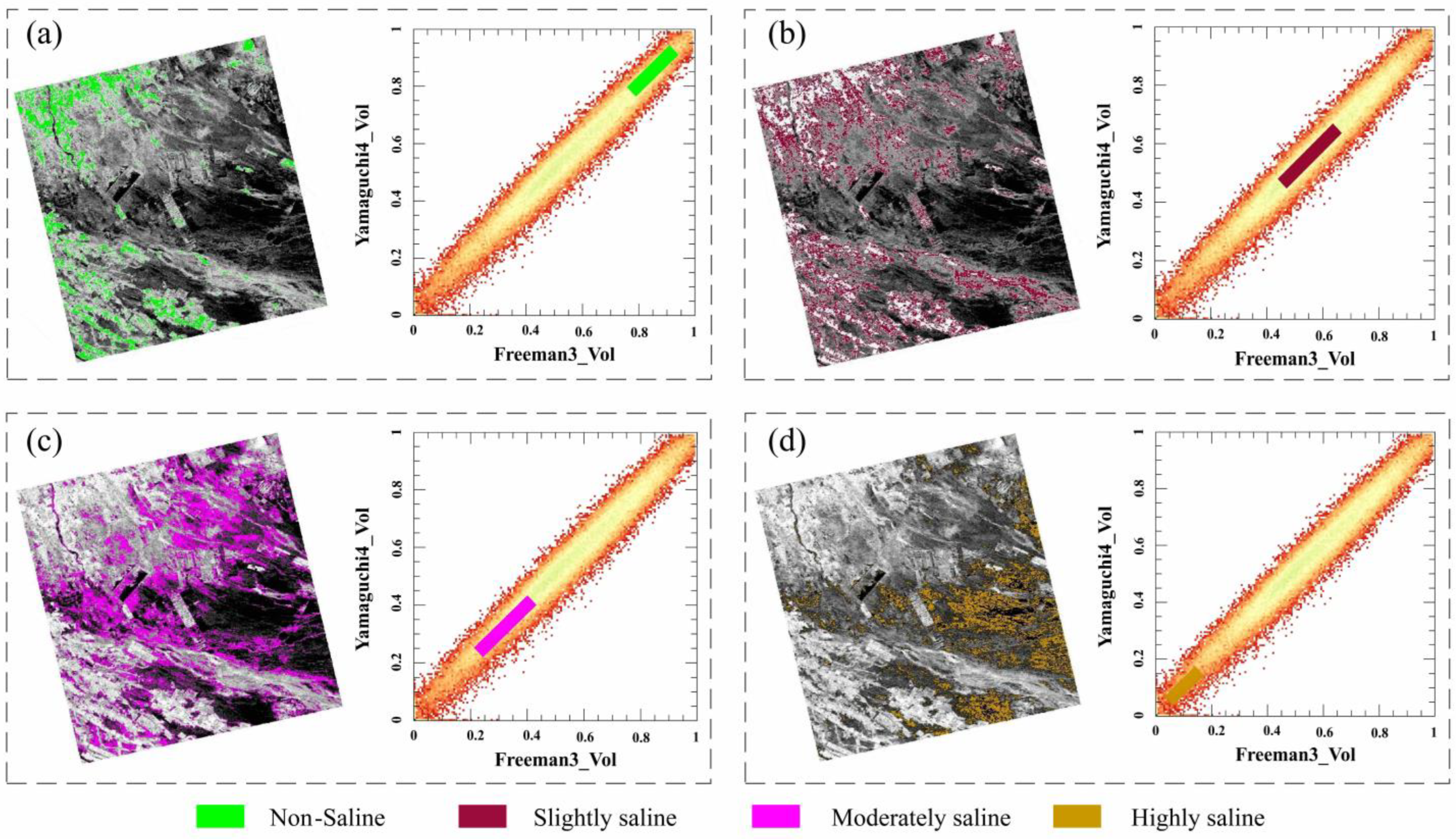

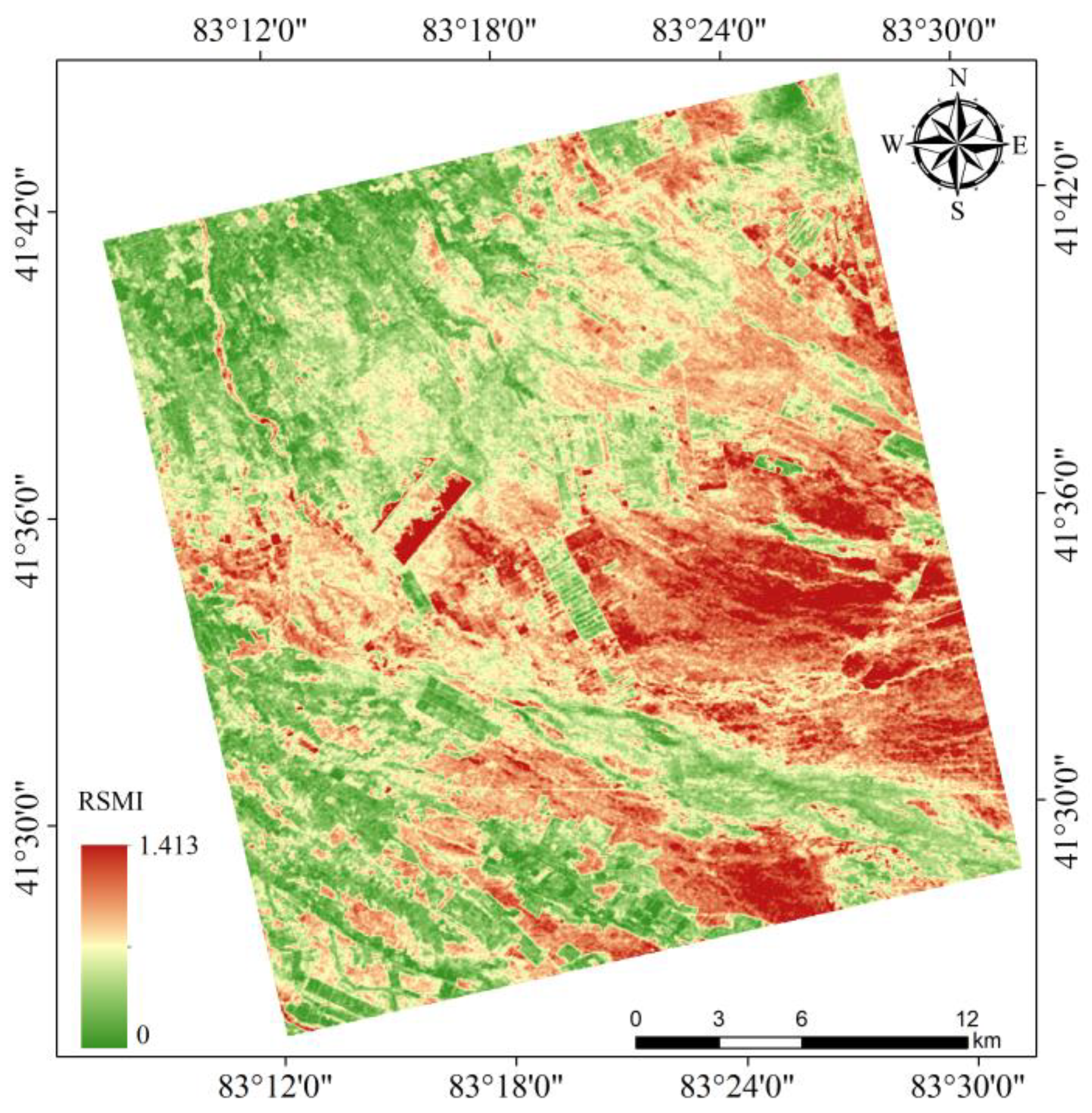
| Parameter Types | Gaofen-3 | RADARSAT-2 |
|---|---|---|
| Product Format | GeoTIFF | GeoTIFF |
| Projection Method | UTM | UTM (WGS84) |
| Imaging Mode | QPSI (Quad-Pol Single-Look) | Fine Quad-Pol |
| Polarization Mode | Quad-Pol (VH, HV, VV, HH) | Quad-Pol (HH, HV, VH, VV) |
| Processing Level | LEVEL 1.1 | SLC (Single Look Complex) |
| Frequency | C-band (1.2 GHz) | C-band (5.405 GHz) |
| Resolution | 2.2 × 5.5 m (Range × Azimuth) | 5.5 m × 4.8 m (Range × Azimuth) |
| Incidence Angle | 35.3° | 41.05° |
| Antenna Look Direction | Right-Looking | Right-Looking |
| Orbit Direction | Descending | Descending |
| Minimum | Maximum | Mean | Median | Standard Deviation | Coefficient of Variation |
|---|---|---|---|---|---|
| 0.137 dS/m | 58.26 dS/m | 13.98 dS/m | 8.63 dS/m | 13.72 dS/m | 98.14% |
| Decomposition Method | Component Number | Decomposition Component | Reference |
|---|---|---|---|
| Freeman2 | 2 | Freeman2_ground, Freeman2_vol. | [53] |
| Freeman3 | 3 | Freeman3_odd, Freeman3_dbl, Freeman3_ vol. | [53] |
| Bar1 | 3 | Bar1_T1, Bar1_T2, Bar1_T3. | [61] |
| Bar2 | 3 | Bar2_T1, Bar2_T2, Bar2_T3. | [61] |
| Cloude | 3 | Cloude_T1, Cloude_T2, Cloude_T3. | [52] |
| H/A/Alpha | 3 | H_A_Alpha_T1, H_A_Alpha_T2, H_A_Alpha_T3. | [48] |
| Holm1 | 3 | Holm1_T1, Holm1_T2, Holm1_T3. | [61] |
| Holm2 | 3 | Holm2_T1, Holm2_T2, Holm2_T3. | [61] |
| Huynen | 3 | Huynen_T1, Huynen_T2, Huynen_T3. | [49] |
| Van Zyl3 | 3 | Van Zyl3_odd, Van Zyl3_dbl, Van Zyl3_vol. | [57] |
| Yamaguchi3 | 3 | Yamaguchi3_odd, Yamaguchi3_dbl, Yamaguchi3_vol. | [54] |
| Yamaguchi4 | 4 | Yamaguchi4_ odd, Yamaguchi4_dbl, Yamaguchi4_vol, Yamaguchi4_hlx. | [54] |
| Variables | r | Variables | r | Variables | r |
|---|---|---|---|---|---|
| Yamaguchi4_vol | −0.67 ** | Huynen_T3 | 0.34 * | Yamaguchi4_odd | −0.19 |
| Freeman3_vol | −0.63 ** | Cloude_T1 | −0.28 * | Huynen_T1 | −0.16 |
| VanZyl3_vol | −0.58 ** | H_A_Alpha_T2 | 0.27 | Yamaguchi3_odd | −0.16 |
| Freeman3_dbl | −0.44 ** | VanZyl3_dbl | −0.27 | Holm1_T1 | −0.15 |
| Freeman2_vol | −0.42 ** | Cloude_T2 | 0.26 | H_A_Alpha_T1 | −0.15 |
| Yamaguchi4_dbl | −0.41 ** | Holm2_T2 | 0.24 | Bar1_T1 | −0.11 |
| Freeman2_ground | 0.41 ** | Bar2_T1 | −0.23 | Bar1_T3 | 0.11 |
| Cloude_T3 | 0.40 ** | Holm1_T2 | 0.22 | Bar2_T3 | 0.10 |
| Holm2_T1 | −0.39 ** | Bar1_T2 | 0.22 | Freeman3_odd | −0.10 |
| Holm2_T3 | 0.38 ** | Yamaguchi3_dbl | −0.22 | Bar2_T2 | −0.07 |
| H_A_Alpha_T3 | 0.37 ** | Huynen_T2 | 0.20 | VanZyl3_odd | −0.02 |
| Holm1_T3 | 0.37 ** | Yamaguchi3_vol | −0.19 | Yamaguchi4_hlx | 0.00 |
Disclaimer/Publisher’s Note: The statements, opinions and data contained in all publications are solely those of the individual author(s) and contributor(s) and not of MDPI and/or the editor(s). MDPI and/or the editor(s) disclaim responsibility for any injury to people or property resulting from any ideas, methods, instructions or products referred to in the content. |
© 2025 by the authors. Licensee MDPI, Basel, Switzerland. This article is an open access article distributed under the terms and conditions of the Creative Commons Attribution (CC BY) license (https://creativecommons.org/licenses/by/4.0/).
Share and Cite
Nurmemet, I.; Aihaiti, A.; Aili, Y.; Lv, X.; Li, S.; Qin, Y. Quantitative Retrieval of Soil Salinity in Arid Regions: A Radar Feature Space Approach with Fully Polarimetric SAR Data. Sensors 2025, 25, 2512. https://doi.org/10.3390/s25082512
Nurmemet I, Aihaiti A, Aili Y, Lv X, Li S, Qin Y. Quantitative Retrieval of Soil Salinity in Arid Regions: A Radar Feature Space Approach with Fully Polarimetric SAR Data. Sensors. 2025; 25(8):2512. https://doi.org/10.3390/s25082512
Chicago/Turabian StyleNurmemet, Ilyas, Aihepa Aihaiti, Yilizhati Aili, Xiaobo Lv, Shiqin Li, and Yu Qin. 2025. "Quantitative Retrieval of Soil Salinity in Arid Regions: A Radar Feature Space Approach with Fully Polarimetric SAR Data" Sensors 25, no. 8: 2512. https://doi.org/10.3390/s25082512
APA StyleNurmemet, I., Aihaiti, A., Aili, Y., Lv, X., Li, S., & Qin, Y. (2025). Quantitative Retrieval of Soil Salinity in Arid Regions: A Radar Feature Space Approach with Fully Polarimetric SAR Data. Sensors, 25(8), 2512. https://doi.org/10.3390/s25082512






